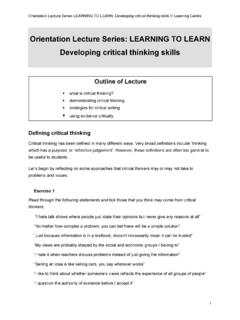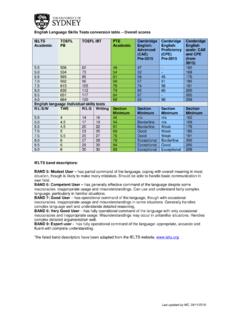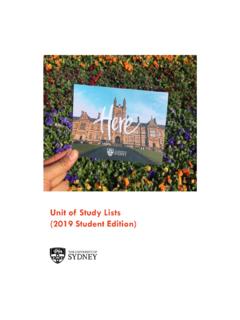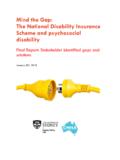Transcription of First year expectations and experiences: student and ...
1 High Educ DOI First year expectations and experiences: student and teacher perspectives Russell Brinkworth Ben McCann Carol Matthews Karin Nordstro m Received: 11 June 2008 / Accepted: 15 November 2008. The Author(s) 2008. This article is published with open access at Abstract Transitioning from high-school to university can be difficult, and many uni- versity teachers feel students are often ill-prepared for the change. To investigate this 233. Humanities and Science students at the University of Adelaide were surveyed 6 months into their First year regarding experiences of teaching and learning at university. 189. students were also surveyed 18 months after commencement, to gain retrospective views of their transition year , as were lecturers and tutors of both groups.
2 Results were compared to similar Orientation Week questionnaires that focused on expectations . Questions included reasons for selecting degrees, quality of teacher feedback and perceived impact of outside commitments. Even though student expectations , student experience , and teacher views differed, remarkable similarities emerged across the two degree programs (Science and Humanities). Our findings thus highlight a call for non-specialised transition programs to meet the needs of First year students and facilitate the transition from secondary to tertiary education. Keywords Tertiary education Transition Mismatch Feedback All authors contributed equally to this work. R. Brinkworth K. Nordstro m (&). School of Molecular and Biomedical Science, The University of Adelaide, Adelaide, SA 5005, Australia e-mail: R.
3 Brinkworth e-mail: B. McCann School of Humanities, The University of Adelaide, Adelaide, SA 5005, Australia e-mail: C. Matthews School of History and Politics, The University of Adelaide, Adelaide, SA 5005, Australia e-mail: 123. High Educ Introduction A 2004 survey of Australian First year students revealed that despite [e]nhanced efforts to bridge the gap between school and university'' over the previous decade, some 60%. of First year students did not feel adequately prepared for university. Around a third of all commencing students even feel ill-prepared to choose a university course on leaving school'' and tend to experience an early reality shock' when their First semester marks begin to come in'' (Krause et al. 2005). According to another study, this sizable minority actually find themselves in difficulties'' once they begin university courses (McInnis 2001).
4 There has been increased scholarly concern in recent times that students are inadequately prepared for entry level university courses and a perception that this has led to falling standards (Trotter and Roberts 2006). The First year experi- ence is especially relevant as it impacts on attrition and thus on university funding, which is often tied to the number of enrolled students . Furthermore, an Australian initiative the Learning and Teaching Performance Fund (Department of Education 2008a) rewards universities for excellence in learning and teaching, tightly linking this to attrition rates. The transition from high school to university is a major concern globally as demon- strated by an extensive (and rapidly expanding) literature. Much of the research in this area originates in the US where, for instance, studies have analysed the academic motivations and attrition rates of various demographic groups, such as low income students and those from ethnic minority groups (Seidman et al.)
5 1995; Tierney 2005), showing that perceived racism had a detrimental effect on student retention (Brown et al. 2005). McCarthy and Kuh (2006) surveyed over 170,000 American high school students and reached the con- clusion that a serious mismatch'' existed between the students ' learning habits and the habits that would be expected of them at university. The transition from high school to university should not be considered a purely Western concern as analyses from other countries indicate. Tolstova (2006) bemoaned an apparently widening gap between Rus- sian secondary and tertiary education and consequent drop in the standard of Russian sociology students . In Europe a study investigating the transition from high school to university found that the combination of increasing student numbers and declining sec- ondary standards contributed to declining university standards and high failure rates during the First year (EMBO 2006).
6 Rausch and Hamilton (2006) highlighted the fact that of the million students commencing at US universities, between 25 and 30% do not return to their initial institution of choice for the second year ''. They noted in particular that the greatest loss occurs during the freshman year , especially during the First semester'' (Rausch and Hamilton 2006). Other studies in the US have pondered ways to enhance academic success during the First crucial year , including foregrounding the voices of minority groups in the classroom and identifying colleges with higher than average success rates (Boler et al. 2004; Kuh et al. 2005; Reason et al. 2006). There is also a deeper problem with envisioning senior schooling as simply a means of entering university.
7 Pressure on some school teachers to get students into university may lead to increased assistance which could set up unrealistic expectations of what students will encounter once in tertiary education. High school students enrolled in educational activities that occur outside formal schooling in Japan are thereby more likely to successfully enter university, as they achieve higher university entrance scores (Ono 2007; Stevenson and Baker 1992). However, such students are also more likely to be from high socioeconomic backgrounds, hence indicating a possible confounding 123. High Educ factor. The focus on university entrance may lead to students from elite schools, where extra attention is granted, perform better at university entrance exams, but then struggle academically once in tertiary education (Birch and Miller 2007).
8 While high rates of student admittance into university are often desirable, it is also important to retain students once enrolled. Studies from the UK, US and Australia show that retention rates, especially after First year , have been an important issue for many universities for at least the last two decades (Betts and Morrell 1999; De Rome and Lewin 1984; Johnes and McNabb 2004). The Australian literature reflects scholars' concerns across a broad range of disci- plines about a very real gap in students ' skills between high school and university, and relates some concerted efforts to ease the transition process for First year students . For example, Macdonald (2000) noted that although moving from secondary education to university has never been easy, in recent times the problem of the transition has become more acute''.
9 This, he argues, is due to changes in sources of university funding and has resulted in a fundamental power shift: from the university to a larger and more diverse student body upon which universities are more dependant financially than was the case 20 years ago. Indeed, as McInnis (2001) states, First year is a priority since it is now recognised that attrition is costly for both individuals and universities''. Accordingly, the literature reflects a similar shift: from analysis of this changing student body in the 1980s (Hester 1982) to suggesting ways in which the experience of transition can be eased. Ternel (2000) identified a mismatch'' between individual learning styles and university teaching methods in mechanical engineering. Furthermore, Hagan and Macdonald (2000).
10 Pointed out that the universities' expectation of students to adjust immediately to a different style of teaching and learning was part of the problem'' of transition to university. Several strategies have been suggested for making the transition easier: Krause (2001). established that the First written assignment, particularly with effective and timely feedback upon it, can promote better integration in text-based courses. Leveson (1999) found small group work to assist accounting students . A study at La Trobe University found structural equation modelling helpful in identifying the characteristics of successful students in health sciences (McKenzie and Gow 2004) and collaboration between computing and IT. proved effective at Monash University (Hagan and Macdonald 2000).









